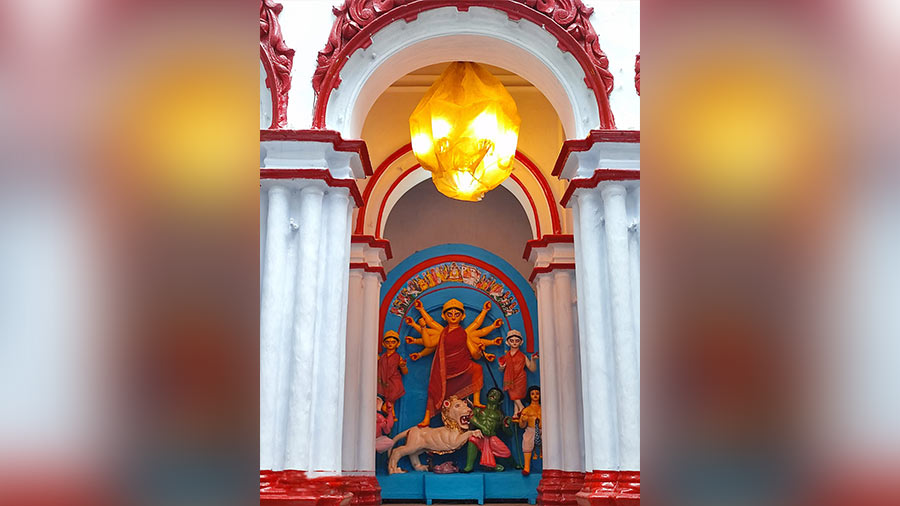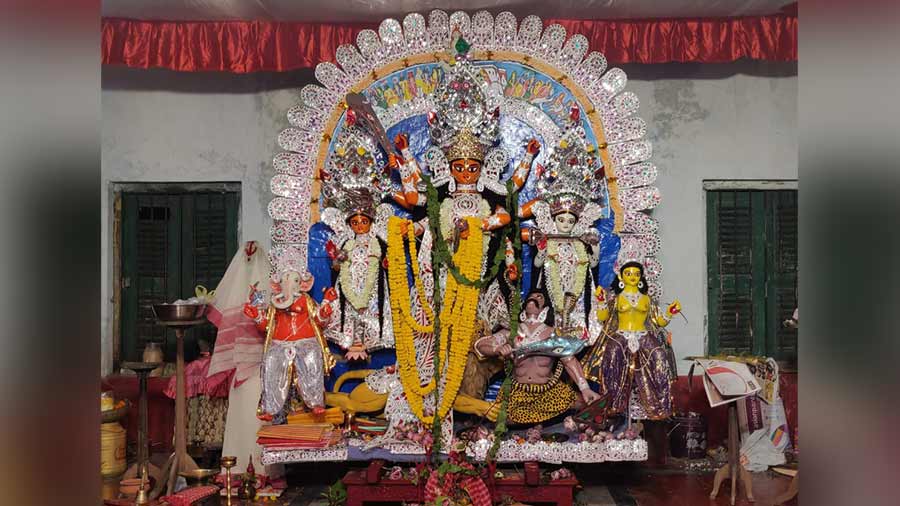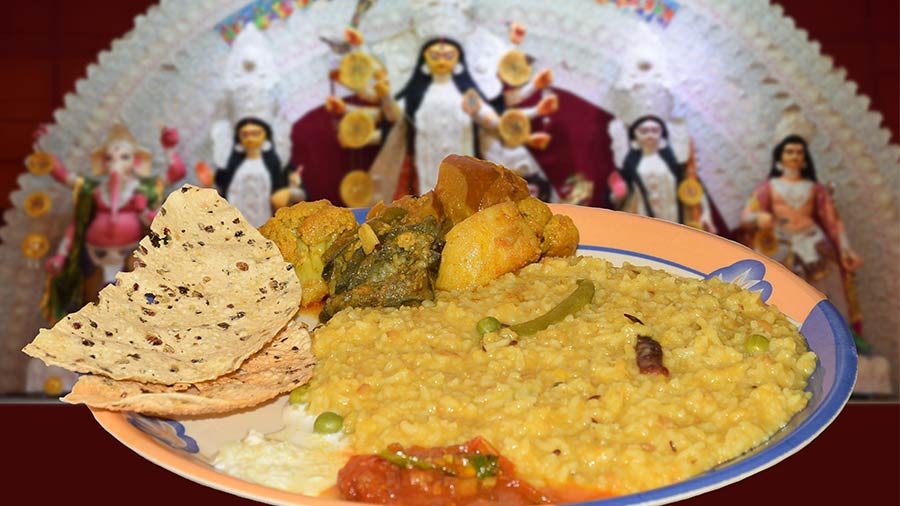Puja rituals remain incomplete without bhog or the offering of food to the deity. Khichudi is what first comes to mind at the very mention of bhog. Khichudi made with the aromatic gobindobhog rice and sona moong dal is served with labra (mixed vegetables), fries like beguni (brinjal), and payesh among other items. Every barir pujo has its own set of rules and rituals revolving around bhog. Some offer anna bhog (bhog cooked with rice), while others don’t. Many offer vegetarian food to the goddess, but some families also offer non-vegetarian dishes like fish and mutton, but cooked without onion or garlic.
My Kolkata speaks to four families about the bhog they offer to the goddess.
Seal family of Chorbagan

The Seal family puja
The bhog offered to the goddess at this 167-year-old puja is vegetarian. The offerings include luchi, kochuri, alu bhaja, potol bhaja, malpua, and different kinds of sandesh. All items are homemade. No item made of rice or rice flour is included in the bhog. All members of the family eat vegetarian food for 10 days during Puja as the rituals begin on Pratipad, the day after Mahalaya.
Malpua
Ingredients:
- Maida: 1 cup
- Sooji: 2 cups
- Sugar: 1 cup
- Fennel: 1 teaspoon
- Black pepper (crushed): ½ teaspoon (optional)
- Water to make the batter
- Refined oil or ghee: 250ml
Method:
- Make a mixture of maida, sooji and sugar by adding water. Stir continuously. Add fennel seeds and crushed black pepper. It should be a batter, not a dough.
- Rest the batter for half an hour
- Heat ghee or oil and pour batter in small quantities to deep fry malpuas.
Dutta Chowdhury family of Andul

The Dutta Chowdhury family puja
The goddess at this puja started by Ramsharan Dutta Chowdhury is worshipped as Raj Rajeshwari. She is offered anno bhog. On Saptami and Ashtami, khichuri is offered to the goddess with five types of bhaja (fried vegetables). On Navami, pulao is offered to the goddess along with five kinds of bhaja and, in the evening, luchi is offered as bhog. The Dashami bhog includes luchi and five kinds of fried items. Different kinds of sweets like narkel naru, Chandrapuli and Monohara are also offered. A special sweet that finds pride of place on top of Maha Naibedya is Agmonda. The triangle-shaped sweet has a filling of mawa, coconut paste and kheer. The outer layer is made with Chandani Kheer. It is decorated with pista, nuts and raisins. All sweets are made at home.
Bhoger khichuri
Ingredients:
- Gobindobhog rice: 250gms
- Sona moong dal: 250gms
- Whole garam masala: 10gms
- Dry Red Chillies: 2
- Bay leaves: 2
- Turmeric powder: 1 teaspoon
- Jeera powder: 1 teaspoon
- Salt to taste
- Sugar: 3 teaspoons
- Mustard oil: 1 tablespoon
- Ghee: 3 teaspoons
- Vegetables (optional)
- Green chillies: 4
- Ginger paste: 1 teaspoon
Method:
- Dry roast dal and soak in water for 20 minutes.
- Clean rice.
- Heat mustard oil, add bay leaves, dry red chillies, whole garam masala. Add ginger paste.
- Add dal and fry. Add the rice and fry. Add all the powdered masala. Add salt and sugar. Stir well.
- Add water double the amount of rice and dal and let it boil.
- When the khichuri is done add ghee.
Chatterjee family of Tollygunge

The Chatterjee family puja
Anna bhog is offered to the goddess at this 95-year-old puja. On Saptami, the goddess is offered khichuri with seven kinds of bhaja like fried pumpkin, fried brinjal, fried sweet potato. Alur dom, labra and borir jhal are also part of the bhog. So are chutney and payesh. On Ashtami, Mishti Pulao is offered with seven kinds of bhaja, alur dom, enchorer torkari, chutney and payesh. The Navami bhog includes rice, kolaier dal, posto, khichuri, mishti pulao, chhanar dalna, chutney and payesh. In the evening, the goddess is offered luchi, halwa and different kinds of sweets. The Dashami naibedya has five kinds of whole pulses (poncho kadai). Dadhikarma is also offered on Dashami.
Mishti Pulao
Ingredients:
- Gobindobhog rice: 500gms
- Ghee: 100gms
- Cashew nuts: 100gms
- Raisins: 100gms
- Saffron: 5 to 6 strands
- Whole garam masala: 2 sticks of cardamom, 4 cardamom pods, 4 cloves
- Bay leaves: 2
- Warm milk: 2 tablespoons
- Sugar: 4 tablespoons
- Salt to taste
Method:
- Clean the rice with water.
- Heat ghee. Add bay leaves and whole garam masala. As they pop, add rice.
- Add salt and sugar. Add raisins and cashew.
- Add water and let it boil.
- When the water almost dries up and the rice is cooked, switch off the gas.
- Add saffron strands to lukewarm milk and add this to the pulao.
- Keep the pulao covered for a while.
Dasgupta family of Barrackpore

The Dasgupta family puja
The bhog offered at this puja, which started in 1662 in Jessore (and in 1956 at Barrackpore), also includes non-vegetarian fare. The bhog here is offered in the evening and called nisha bhog. On Saptami, Ashtami and Navami, bhog is offered to the goddess in two large stone dishes — one has gobindobhog rice (shoa kilo in weight which is roughly 1,200gms.), two types of dal and five kinds of bhaja, which must include a shaak (leafy green) and a tail piece of fish. The bhog also includes one vegetable curry and two kinds of fish — one chhoto maachh (small fish) and another item made of rui, katla or bhetki or other large fish. Only fish with scales can be offered. The fish curry is cooked without any onion or garlic.Lau chingri is another speciality that is part of the bhog here. Ghee and karonbari (liquor) are also offered in two large bowls. Luchi fried in ghee and payesh is also offered. The second dish has gondhoraj lebu, curd, mortoman kola (banana), naru and khorke kathi (toothpicks made of wood). In the morning fruits and sweets are offered. Panta bhog is offered on Dashami — panta bhaat (fermented rice), kochur shaak and maachh bhaja. Narkel naru (white and brown), kheerer chhap sandesh, narkeler chhaap sandesh and jeere chire (made of coconut and sugar) are all made in the house and offered to the goddess. A special kind of jalpai chutney made with jalpai, tamarind, aamada and sweet potato is also served.
Lau Chingri
Ingredients:
- Lau (bottle gourd): 1
- Prawn: 150 gms (small ones)
- Bay leaf: 2
- Whole cumin: ½ teaspoon
- Turmeric powder: 1 teaspoon
- Salt to taste
- Sugar: ½ teaspoon
- Green chillies: 5 to 6
- Mustard oil: 3 tablespoons
Method:
- Shred the gourd.
- Sprinkle some turmeric powder and salt on the prawns.
- Heat mustard oil and fry the prawns.
- Add bay leaves and whole cumin. After they pop up, add the shredded gourd. The gourd will release water. Let it cook.
- When the water almost dries up, add salt, sugar and turmeric powder. Stir it continuously until it becomes dry. Add green chillies and mix.
- Add the prawns and stir a little.
- Turn off the heat and keep covered for a few minutes
